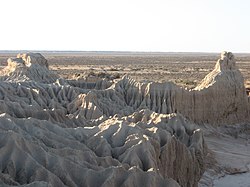Mungo National Park is an Outback park in the southern Far West region of New South Wales. It is part of the Willandra Lakes World Heritage site.
Understand
[edit]
Mungo National Park may seem a little unremarkable, aside for a few interesting landmarks, given how far it is from pretty much everything, but archaeologically it is an extremely important site. Remains known as "Mungo Man" and "Mungo Lady", the oldest human remains discovered in Australia and the oldest known human in the world to have been ritually cremated respectively, were discovered here.
History
[edit]Landscape
[edit]The landscape is typical Outback. The two main features in the park are the dry Lake Mungo and the Walls of China, a series of beautiful natural lunettes of sand.
Flora and fauna
[edit]Kangaroos are common. Echidnas and emus can also be found, as well as a range of many other animals.
Climate
[edit]The area is a desert. In the summer, temperatures can easily reach well above 40°C, while winter nights can drop below 0°C.
Visitor information centre
[edit]Get in
[edit]All roads to Mungo National Park are unpaved for at least the last few dozens of kilometres before the park. It is about a two-hour drive (110 km) from Mildura, the nearest city. During (or after) rare rain, the roads can be blocked, which means if you are in the park, you could be stuck there for some time.
Fees and permits
[edit]Vehicle entry fees are $8 per vehicle per day. Payment is by self-registration, envelopes and information available from the front of the visitor centre. Camping in the park overnight also requires a fee ($5 per adult, $3 per child), which you can pay at the visitor center.
Get around
[edit]Dirt roads in relatively good condition get to all points of interest in the park.
See
[edit]- Lake Mungo
- 1 Mungo lookout, Mungo Lookout Road, Mungo.
- 2 Walls of China viewing platform, China Walls Walking Track, Mungo, ☏ +61 3 5021 8900.
- Red Top lookout and boardwalk. Gives views of some extraordinary landscapes.
Do
[edit]- Walls of China - a 70-km self-guided drive circles these formations and provides good views.
Buy
[edit]Eat
[edit]There aren't any places to eat, so you'll need to bring your own food.
Drink
[edit]Sleep
[edit]Lodging
[edit]- Shearers Quarters - next to the visitor centre, the park's historic shearers' quarters has 5 rooms: 2 with a double and 2 bunks, 2 with 3 bunks and 1 with 2 singles. No bedding provided. There is also a communal kitchen and dining room, showers, a toilet block, and hot water. $30 per adult per night (16 years and over); $10 per child per night (5-15 years); children under 5 years free. Minimum charge of $50 per night.
- Mungo Lodge - 4-star private accommodation. There is a private airstrip next to the lodge.
Camping
[edit]The main campground has 33 sites, and is close to all major features of the park.
Belah campground is a little more remote and has 12 campsites.
Stay safe
[edit]- This area is hot and dry - drink a lot. Also, check the weather before going: in the off-chance of rain, you might find yourself stranded for a while.
- Remember that there's barely any mobile signal with you. Also, this area uses +613 rather than +612, which is used in NSW.

